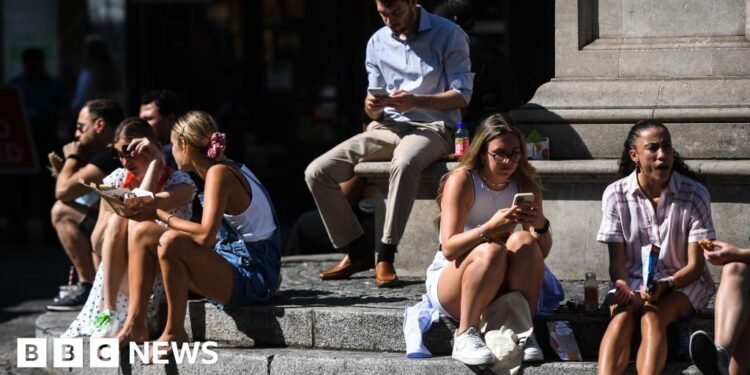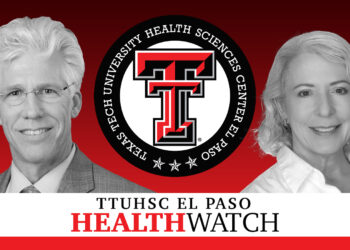 Getty Images
Getty ImagesWarm weather can often bring high levels of ultraviolet (UV) radiation.
UV radiation is emitted by the Sun and penetrates the Earth’s atmosphere.
Some exposure is essential for our wellbeing, but too much can cause skin damage.
Is UV dangerous?
UV is beneficial because it enables our skin to produce essential vitamin D.
This is important for the function of bones, blood cells and our immune system.
But we need to be careful about how much time we spend in the sunshine, warns Prof Dorothy Bennett, from St George’s, University of London.
“Every exposure to UV, especially every sunburn, increases our risk of skin cancer.
“Melanoma, the most dangerous skin cancer, is now the fifth commonest cancer in the UK, the ongoing rise being attributed to sunbathing.”
UV radiation promotes skin cancer by damaging DNA in skin cells.
It also plays a substantial role in skin ageing, contributing to wrinkles and loosened folds.
UV exposure has also been linked to eye problems, including cataracts.
What is the UV index?
Levels of UV radiation vary throughout the day.
The highest readings occur in the four-hour period around “solar noon”, when the sun is at its highest – usually from late morning to early afternoon.
The UV Index (or UVI) is a standard, international measure of ultraviolet radiation.
Values start at zero and can rise above 10.
The higher the number, the greater the potential for damage to the skin and eyes – and the less time it takes for harm to occur.
What are the different UV levels?

Countries close to the equator can experience very high UV levels in the middle of the day, throughout the year.
Nairobi in Kenya can have UV levels above 10 all year, according to the World Health Organization (WHO).
Majorca in Spain normally hits nine in June and July.
But the Falkland Islands in the South Atlantic never usually get above five, even in summer.
What do the different UV levels mean for people?
According to the WHO, no sun protection is required when levels are:
Some sun protection is required when levels are:
Extra sun protection is required when UV levels are:
- 11+ (extremely high)
- 8-10 (very high)
Children are more sensitive to UV radiation than adults, and therefore require additional protection at lower levels.
How can you avoid UV damage?
The NHS advises:
- spending time in the shade when the sun is strongest – between 11:00 and 15:00 from March to October in the UK
- covering up with suitable clothing and wearing sunglasses
- using sunscreen which is factor 30 or above and offers at least 4-star UVA protection on your face, neck and other areas of exposed skin
- reapplying sunscreen regularly – check the instructions on the bottle
- making sure babies and children are protected
Global research shows people often miss parts of their bodies when putting on sunscreen, according to Dr Bav Shergill from the British Association of Dermatologists.
“People often forget the side of their nose – where I have seen a lot of skin cancer,” he says.
Other areas which need to be covered include the temples and the upper chest.
As a guide, adults should aim to apply about six to eight teaspoons of sunscreen if covering the entire body.
Can you tan safely?
There is no safe or healthy way to get a tan, according to the NHS.
Dr Shergill recommends using self-tan products instead.
“When you tan, ultraviolet light stimulates your skin cells to produce pigment to try and protect the DNA of skin cells – but that protection is minimal – the equivalent of SP4.
“That is not much protection at all – so you can still burn very early,” he warns.
Can you burn even when it is cloudy and windy?
The amount of UV reaching your skin is not driven by the daily temperature, says Dr Michaela Hegglin, from the University of Reading.
“UV levels on a bright and breezy late April day in the UK will be about the same as a warm sunny day in August.”
“Your skin can burn just as quickly whether it’s 30C or 20C,” warns BBC Weather’s BBC Weather’s Helen Willetts.
“Don’t be caught out on cloudy days. UV will still penetrate thin clouds – so even if you don’t think it’s that sunny, you can still burn.”
I have brown skin. Do I need to worry?
Yes, according to Dr Shergill.
“The skin may look darker, but it doesn’t always behave that way from a protection point of view – because there are more genes at play than we think about,” he says.
“I have, for example, seen South Asian people with skin cancer and I have seen people with dual-heritage get skin cancer.”
The broader risks of eye damage and harmful effects on the immune system from too much UV radiation affect people of all skin colour.
Source link : https://www.bbc.com/news/articles/ckmg1572e8ko?at_medium=RSS&at_campaign=rss
Author :
Publish date : 2025-06-17 09:21:00
Copyright for syndicated content belongs to the linked Source.









